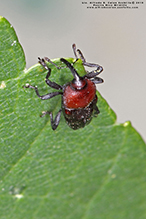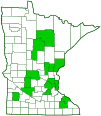wavy flower weevil
(Madarellus undulatus)
Conservation • Description • Habitat • Ecology • Distribution • Taxonomy
|
|
||||||||||||||
Description |
Wavy flower weevil is a small, shiny, black and red, beetle. It occurs in North America from Nova Scotia to Florida west to South Dakota and Texas. It is uncommon in Minnesota. It feeds on grape, Virginia creeper, woodbine, and eastern poison ivy. Adults are ⅛″ to 3⁄16″ (2.6 to 4.7 mm) and inversely egg-shaped, widest toward the front and directed downward toward the narrow rear. It has neither scales nor hairs (setae). The head is red and is greatly elongated between the eyes and the mouth parts form a conspicuous snout (rostrum). The rostrum is well-developed, narrow, and very long, one-fourth the length of the entire body. It is projected forward and slightly bent downward. It is mostly black, red just at the base. The sides are coarsely pitted (punctured), the top finely punctured. The antennae are short, slender, and elbowed. They have 11 segments. The last 3 segments are expanded and form a club. The thorax is composed of three segments. The first segment (prothorax) is large and prominent and appears to be the entire thorax. It is covered by a saddle-shaped plate (pronotum). The pronotum is rectangular and twice as wide as long, much wider than the head. It is shiny and usually red, sometimes dark red, occasionally black. The sides are broadly rounded but abruptly constricted just behind the head. The surface is sparsely punctured. There are two pairs of wings, a membranous inner pair and a hardened outer pair (elytra). The elytra are attached to the second thoracic segment (mesothorax). They cover the mesothorax, the third thoracic segment (metathorax), and completely cover the abdomen. They are slightly narrower than the pronotum, narrowed toward the tips and constricted just behind the pronotum. They are slightly constricted in the middle, making them appear wavy when viewed from above. They are black, narrowly grooved (striate), and have narrow rows of deep punctures. Toward the inner margin, the spaces between the deep punctures is flat, smooth, and sparsely covered with fine punctures. Toward the sides these spaces are rougher. There is a small plate (mesepimeron) on each side between the pronotum and the elytra in the shoulder area. The mesepimeron is raised and is visible from above. This is an identifying feature of the subfamily Baridinae. The legs are black and densely covered with large punctures. The last part of each leg (tarsus), corresponding to the foot, has five segments but the fourth segment is minute and is concealed within the lobes of the heart-shaped third segment, making it appear that there are only four segments. At the end of each tarsus there are two hooked claws. |
Size |
Total length: ⅛″ to 3⁄16″ (2.6 to 4.7 mm) |
Similar Species |
Habitat |
Savannas. Grape, Virginia creeper, woodbine, and eastern poison ivy. |
Ecology |
Season |
April to late September (CCESR) |
Behavior |
|
Life Cycle |
|
Larva Food |
Grape, Virginia creeper, woodbine, and eastern poison ivy |
Adult Food |
Grape, Virginia creeper, woodbine, and eastern poison ivy |
Distribution |
||
|
Sources Biodiversity occurrence data published by: Minnesota Biodiversity Atlas (accessed through the Minnesota Biodiversity Atlas Portal, bellatlas.umn.edu, 7/10/2025). |
|
| 7/10/2025 | ||
Occurrence |
||
|
||
Taxonomy |
|
Order |
Coleoptera (Beetles) |
Suborder |
Polyphaga (Water, Rove, Scarab, Long-horned, Leaf, and Snout Beetles) |
Infraorder |
Cucujiformia |
Superfamily |
Curculionoidea (snout and bark beetles) |
Family |
Curculionidae (true weevils) |
Subfamily |
Baridinae (flower weevils) |
Tribe |
Madarini |
Genus |
Madarellus |
Subordinate Taxa |
|
|
|
Synonyms |
|
|
|
Common Names |
|
wavy flower weevil |
|
Glossary
Elytra
The hardened or leathery forewings of beetles used to protect the fragile hindwings, which are used for flying. Singular: elytron.
Pronotum
The exoskeletal plate on the upper side of the first segment of the thorax of an insect.
Prothorax
The first (forward) segment of the thorax on an insect, bearing the first pair of legs but not wings.
Rostrum
The stiff, beak-like projection of the carapace or prolongation of the head of an insect, crustacean, or cetacean.
Seta
A stiff, hair-like process on the outer surface of an organism. In Lepidoptera: A usually rigid bristle- or hair-like outgrowth used to sense touch. In mosses: The stalk supporting a spore-bearing capsule and supplying it with nutrients. Plural: setae. Adjective: setose.
Visitor Photos |
||
Share your photo of this insect. |
||
This button not working for you? |
||
Alfredo Colon |
 |
MinnesotaSeasons.com Photos |
||
|
||
|
||

Slideshows |
|

Visitor Videos |
||
Share your video of this insect. |
||
This button not working for you? |
||
|
Other Videos |
||
|

Created: 10/19/2020 Last Updated: © MinnesotaSeasons.com. All rights reserved. |


